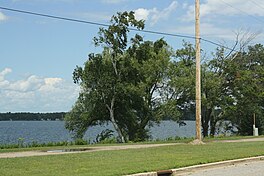| Pelican Lake | |
|---|---|
| Gaa-wabaataawangaag-zaaga'igan (Ojibwe) | |
 Looking northwest at Pelican Lake Looking northwest at Pelican Lake | |
  | |
| Location | Oneida County, Wisconsin |
| Coordinates | 45°30′15″N 89°12′12″W / 45.504127°N 89.203453°W / 45.504127; -89.203453 |
| Type | Drainage |
| Primary outflows | Pelican River |
| Catchment area | Pelican River Watershed, Upper Wisconsin Basin |
| Basin countries | United States |
| Surface area | 3,585 acres (14.51 km) |
| Max. depth | 39 ft (12 m) |
| Water volume | 2.175 billion cubic feet (61.6×10 |
| Shore length | 13 mi (21 km) |
| Surface elevation | 1,591 ft (485 m) |
| Shore length is not a well-defined measure. | |
Pelican Lake is a 3,585-acre (14.51 km) lake located in Oneida County in Wisconsin. It has a maximum depth of 39 ft (12 m). Visitors have access to the lake from five public boat landings. A dam is located on the lake's primary outlet, which feeds into the Pelican River. Pelican Lake serves as one of 21 reservoirs used to regulate and maintain optimal water flow on the Wisconsin and Tomahawk rivers, the process of which is facilitated in part by the Wisconsin Valley Improvement Company.
Fish inhabiting the lake include muskie, panfish, largemouth bass, smallmouth bass, northern pike and walleye. The lake's water clarity has historically been low, and its bottom composition is 40% sand, 20% gravel, 10% rock, 30% muck. The lake is eutrophic. Several invasive species are or have been found in the lake, including banded mystery snail, Chinese mystery snail, curly-leaf pondweed, Eurasian water-milfoil, purple loosestrife, and rusty crayfish.
Pelican Lake was named for the American white pelicans seen there. In the Ojibwe language, the lake goes by either Zhede-zaaga'igan (pelican lake) or more commonly as Gaa-wabaataawangaag-zaaga'igan (place where there is a sandy narrows lake).
References
- "Watersheds and Basins - Upper Wisconsin Basin". Wisconsin Department of Natural Resources - Official Website. Retrieved 4 April 2013.
- "Wisconsin River Reservoir System Summary - Gross Storage". Wisconsin River Improvement Company. Retrieved 4 April 2013.
- "LPL-582 - Lakes Planning Report Document, Page 36". Wisconsin Department of Natural Resources - Official Website. North Central Wisconsin Regional Planning Commission. Retrieved 4 April 2013.
- "Reservoirs". Wisconsin Valley Improvement Company. Retrieved 4 April 2013.
- Wisconsin Department of Natural Resources. "Pelican Lake - Facts & Figures". Retrieved 4 April 2013.
- Chicago and North Western Railway Company (1908). A History of the Origin of the Place Names Connected with the Chicago & North Western and Chicago, St. Paul, Minneapolis & Omaha Railways. p. 112.
External links
- Pelican Lake at Lake-Link.com
- U.S. Geological Survey Geographic Names Information System: Pelican Lake (Wisconsin)